
The mechanism described above helps explain why other ineffective osmoles that increase serum osmolarity (e.g., glucose) are not independent drivers of thirst.
t.ly/odecD
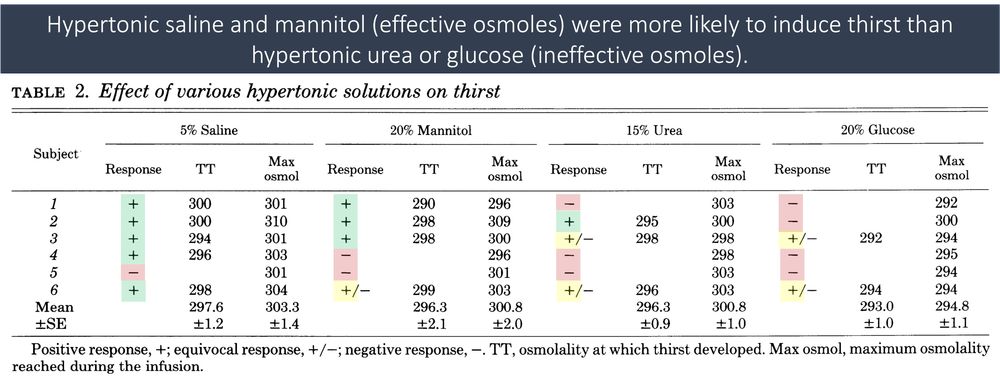
The mechanism described above helps explain why other ineffective osmoles that increase serum osmolarity (e.g., glucose) are not independent drivers of thirst.
t.ly/odecD
The explanation above leads to a beautiful symmetry of thirst promoters.
Either...
➤EXTRAcellular volume depletion
...or...
➤INTRAcellular volume depletion...
...will make you seek water.
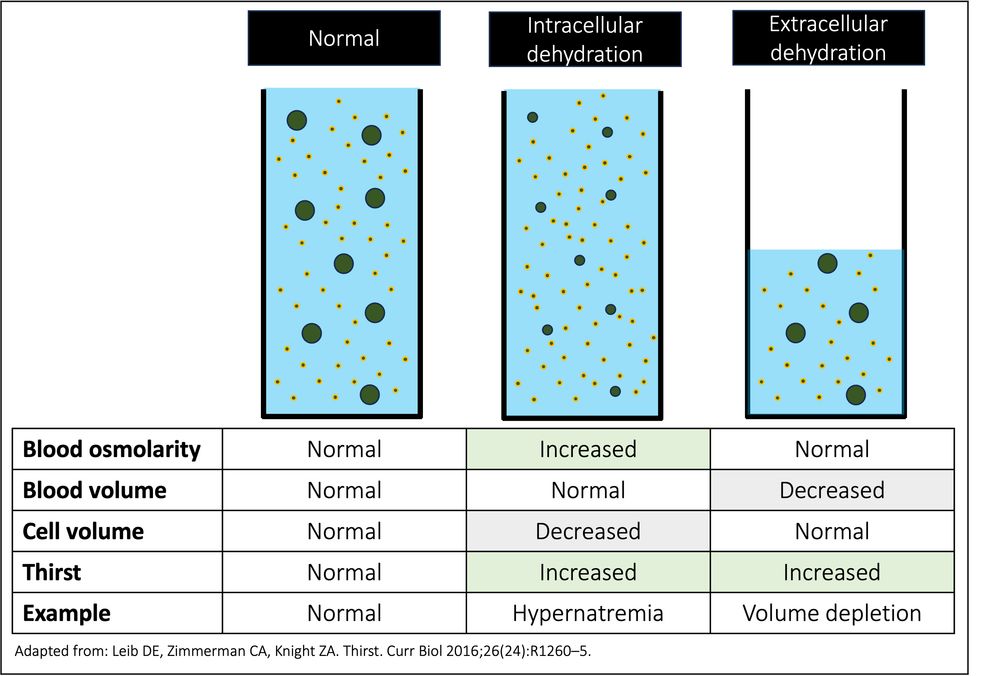
The explanation above leads to a beautiful symmetry of thirst promoters.
Either...
➤EXTRAcellular volume depletion
...or...
➤INTRAcellular volume depletion...
...will make you seek water.
What is the "sensor" for cellular dehydration?
It appears that transient receptor potential vanilloid 1 (TRPV1) is key. TRPV1 is a non-selective cation channel that detects harmful stimuli like heat and capsaicin.
💡 It is also activated by cell shrinking!
t.ly/lqhvy
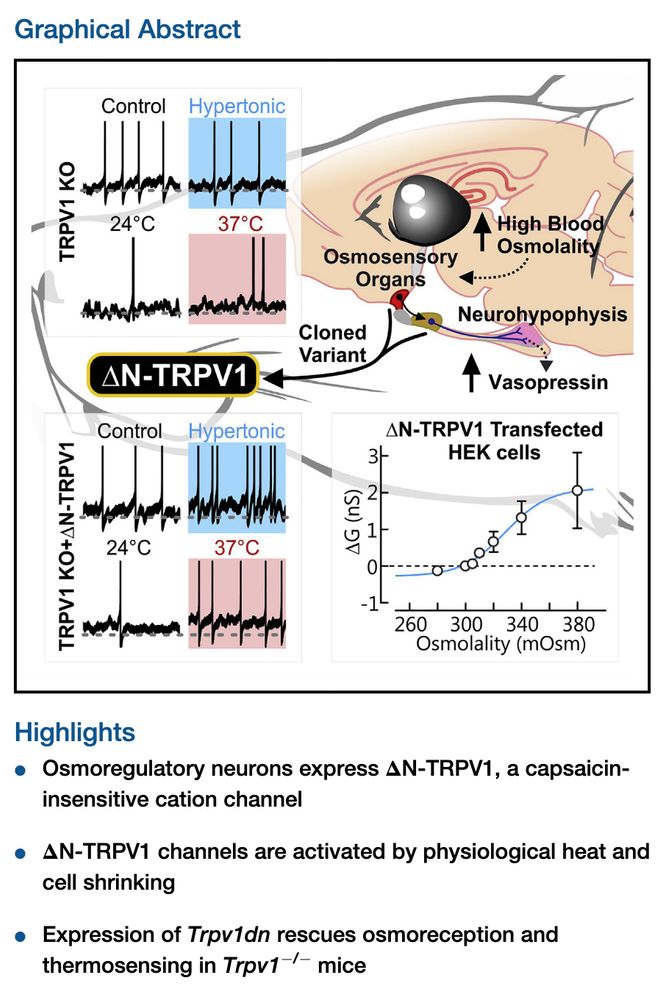
What is the "sensor" for cellular dehydration?
It appears that transient receptor potential vanilloid 1 (TRPV1) is key. TRPV1 is a non-selective cation channel that detects harmful stimuli like heat and capsaicin.
💡 It is also activated by cell shrinking!
t.ly/lqhvy
Based on this experiment, Gilman concluded that it is INTRAcellular dehydration that leads to thirst.
This results from a hypertonic extracellular space (e.g., hypernatremia) and the movement of water outside of cells.
t.ly/It2oB

Based on this experiment, Gilman concluded that it is INTRAcellular dehydration that leads to thirst.
This results from a hypertonic extracellular space (e.g., hypernatremia) and the movement of water outside of cells.
t.ly/It2oB
Gilman then made another crucial observation:
💡Only NaCl led to a reduction in serum specific gravity. This suggested a shift of water from the intracellular to the extracellular space.
This only occurs with an effective osmole (e.g., sodium) and not an ineffective osmole (e.g., urea).
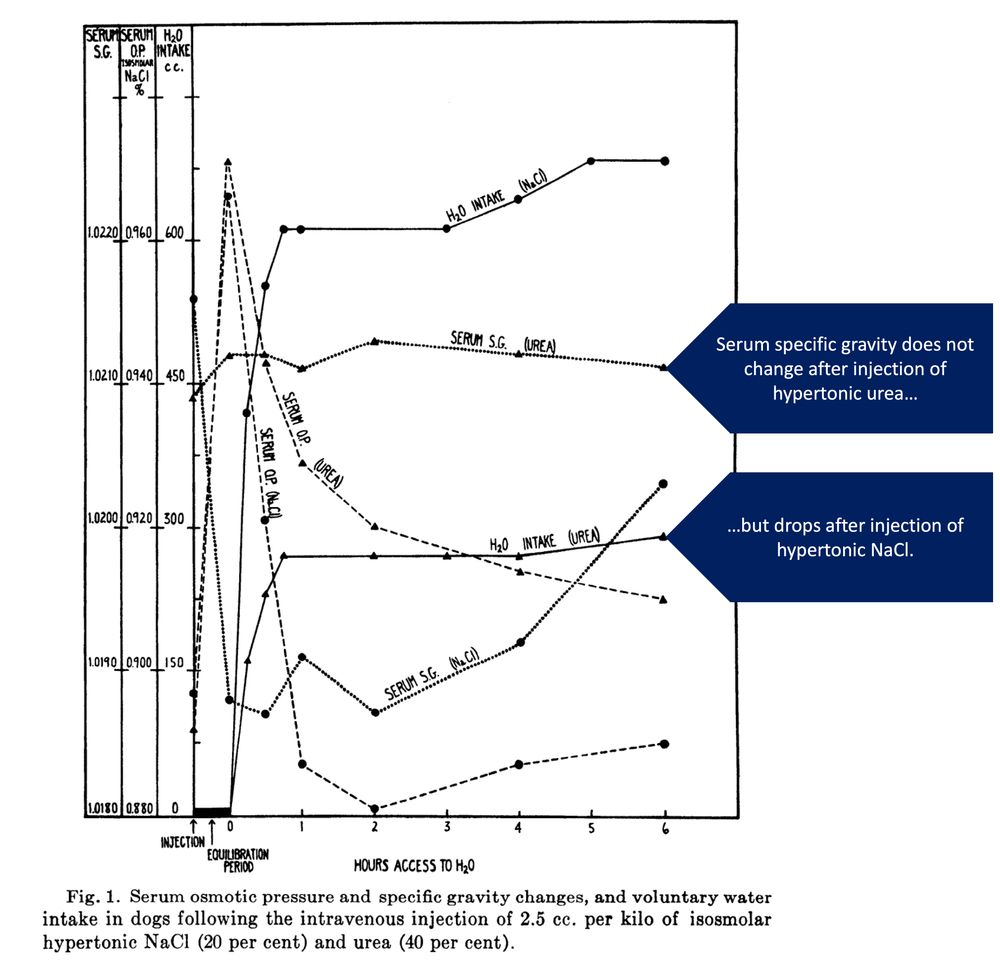
Gilman then made another crucial observation:
💡Only NaCl led to a reduction in serum specific gravity. This suggested a shift of water from the intracellular to the extracellular space.
This only occurs with an effective osmole (e.g., sodium) and not an ineffective osmole (e.g., urea).
After 30 minutes, the dogs were offered water, and had blood work drawn. Gilman made two key observations:
🔑 The increase in serum osmolarity with hypertonic NaCl and urea were nearly identical
🔑 Dogs drank significantly more water after hypertonic NaCl injection
t.ly/MIdqH

After 30 minutes, the dogs were offered water, and had blood work drawn. Gilman made two key observations:
🔑 The increase in serum osmolarity with hypertonic NaCl and urea were nearly identical
🔑 Dogs drank significantly more water after hypertonic NaCl injection
t.ly/MIdqH
We've known for nearly a century that an increase in serum urea is not a significant driver of thirst.
In 1937, Alfred Gilman published an experiment in which dogs received an IV injection of either:
➤20% NaCl
➤40% urea
Both are hypertonic solutions.
t.ly/MIdqH

We've known for nearly a century that an increase in serum urea is not a significant driver of thirst.
In 1937, Alfred Gilman published an experiment in which dogs received an IV injection of either:
➤20% NaCl
➤40% urea
Both are hypertonic solutions.
t.ly/MIdqH
It will be interesting to see if nemolizumab, an interleukin-31 receptor alpha antagonist, helps mitigate lymphoma-associated pruritus in the rare case when it becomes refractory.
This drug has been tested in atopic dermatitis with pruritus and was effective.
t.ly/-i6US

It will be interesting to see if nemolizumab, an interleukin-31 receptor alpha antagonist, helps mitigate lymphoma-associated pruritus in the rare case when it becomes refractory.
This drug has been tested in atopic dermatitis with pruritus and was effective.
t.ly/-i6US
The mechanism involves a cytokine unfamiliar to me: IL-31.
In one study of HL and angioimmunoblastic T-cell lymphoma, those with pruritis had higher serum levels of IL-31, IL-1β, and IL-1α than those with lymphoma and no pruritis compared with controls.
t.ly/KxLw9
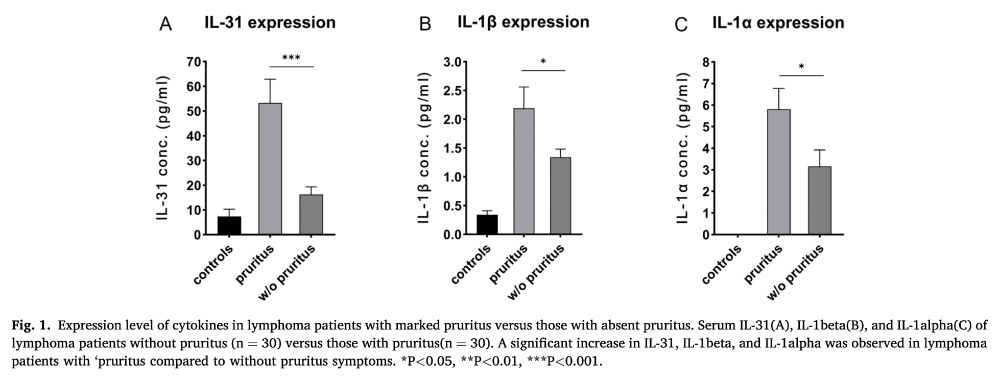
The mechanism involves a cytokine unfamiliar to me: IL-31.
In one study of HL and angioimmunoblastic T-cell lymphoma, those with pruritis had higher serum levels of IL-31, IL-1β, and IL-1α than those with lymphoma and no pruritis compared with controls.
t.ly/KxLw9
The association between HL (and other lymphomas) and pruritus has prompted many to recommend a chest x-ray as part of the initial work-up when a primary skin disorder isn't present.
A 2013 NEJM review suggests this, as does Up-To-Date.
t.ly/wB5Xv
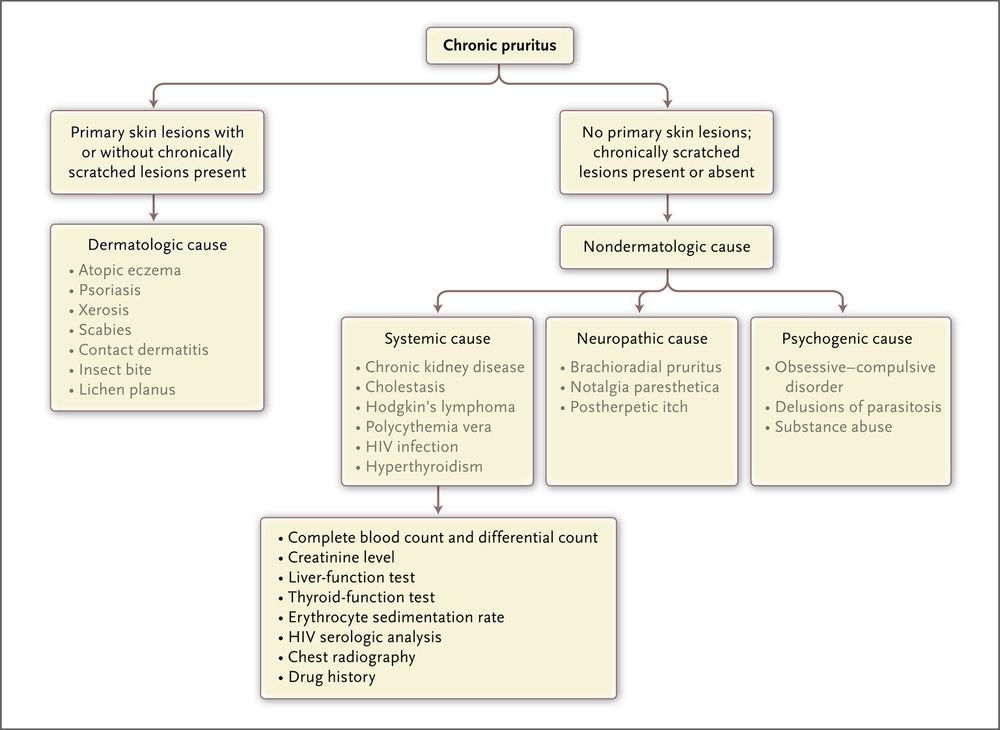

The association between HL (and other lymphomas) and pruritus has prompted many to recommend a chest x-ray as part of the initial work-up when a primary skin disorder isn't present.
A 2013 NEJM review suggests this, as does Up-To-Date.
t.ly/wB5Xv
What is the mechanism of pruritus/itching in Hodgkin Lymphoma (HL)?
For today's Morning Report, Chief Resident Carter Baughman shared a case of HL that presented with months of pruritus. I was surprised to learn that up to 30% of patients with HL present with this symptom.
t.ly/RU2Qj
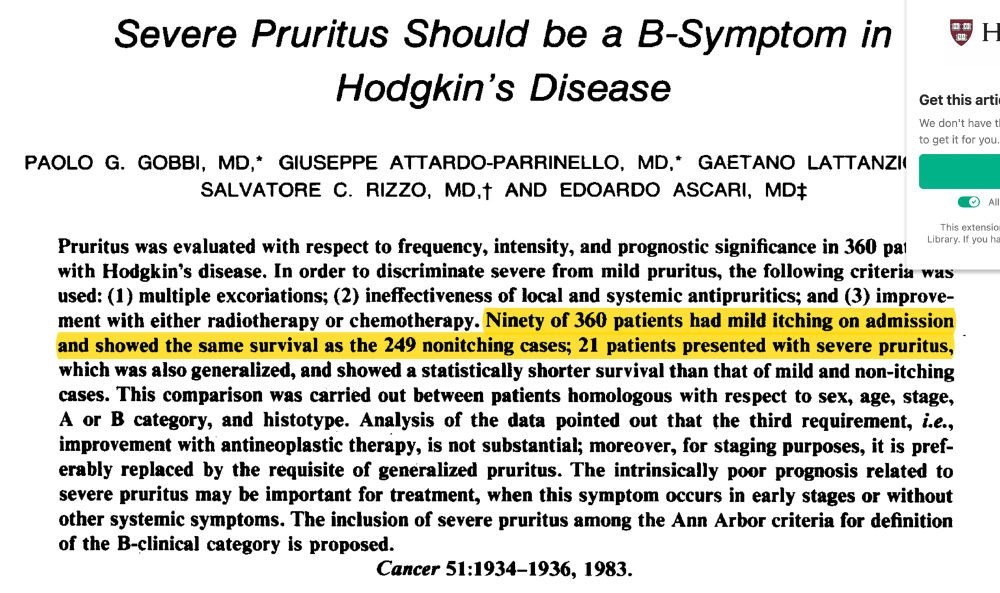
What is the mechanism of pruritus/itching in Hodgkin Lymphoma (HL)?
For today's Morning Report, Chief Resident Carter Baughman shared a case of HL that presented with months of pruritus. I was surprised to learn that up to 30% of patients with HL present with this symptom.
t.ly/RU2Qj
Many heavier elements have been shown to be superior as contrast agents. Whether we'll see them emerge as replacements for iodine isn't yet clear to me.
Stay tuned!
https://buff.ly/3OaBj2f

Many heavier elements have been shown to be superior as contrast agents. Whether we'll see them emerge as replacements for iodine isn't yet clear to me.
Stay tuned!
https://buff.ly/3OaBj2f
Even gold (79) has been reexamined. It works but is just a bit too pricey to replace iodine.
https://buff.ly/40Sgv7k

Even gold (79) has been reexamined. It works but is just a bit too pricey to replace iodine.
https://buff.ly/40Sgv7k
If heavier elements can provide more "contrast," why don't we utilize others that are high-Z?
It turns out that this exact question is being explored.
Gadolinium (64), holmium (67), ytterbium (70), hafnium (72), tantalum (73), and tungsten (74) have all been compared to iodine.

If heavier elements can provide more "contrast," why don't we utilize others that are high-Z?
It turns out that this exact question is being explored.
Gadolinium (64), holmium (67), ytterbium (70), hafnium (72), tantalum (73), and tungsten (74) have all been compared to iodine.
Our current oral contrast agent (barium) is also a heavy element (atomic number 56).
Notice in this figure from radiopaedia that barium is darker than bone. This makes sense, given that the former is high-Z compared to the latter's calcium and phosphorus.
https://buff.ly/4et6eBK

Our current oral contrast agent (barium) is also a heavy element (atomic number 56).
Notice in this figure from radiopaedia that barium is darker than bone. This makes sense, given that the former is high-Z compared to the latter's calcium and phosphorus.
https://buff.ly/4et6eBK
This helps explain why bones appear more opaque on x-rays when compared to surrounding soft tissues.
Bone contains significant amounts of calcium and phosphorus, which are heavier elements than those contained within muscle and fat.


This helps explain why bones appear more opaque on x-rays when compared to surrounding soft tissues.
Bone contains significant amounts of calcium and phosphorus, which are heavier elements than those contained within muscle and fat.
Fat, muscle, and other soft tissues are primarily comprised of carbon, hydrogen, nitrogen, and oxygen. These smaller elements absorb few X-rays.
When injected into a blood vessel, iodine will absorb more X-rays, appear more opaque, and provide "contrast" with surrounding soft tissues.
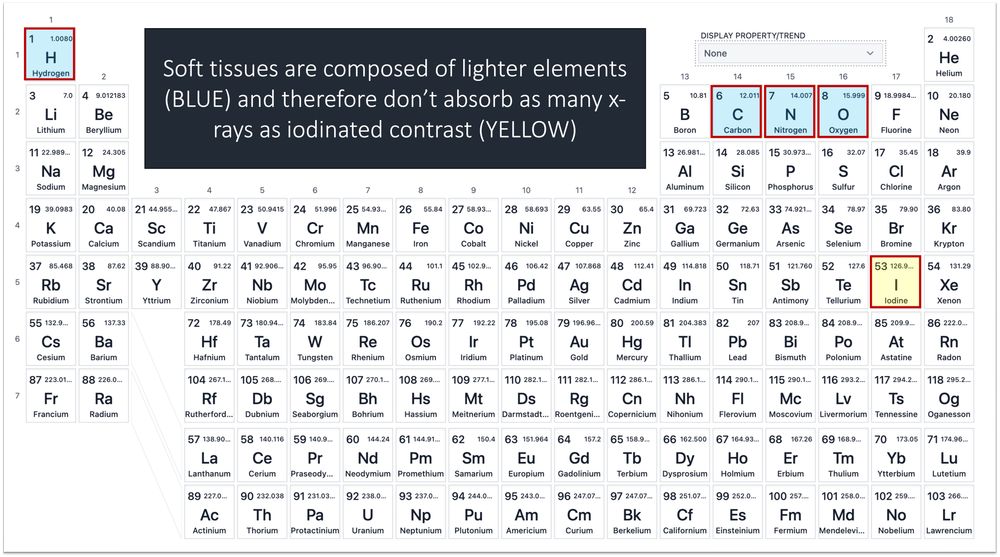
Fat, muscle, and other soft tissues are primarily comprised of carbon, hydrogen, nitrogen, and oxygen. These smaller elements absorb few X-rays.
When injected into a blood vessel, iodine will absorb more X-rays, appear more opaque, and provide "contrast" with surrounding soft tissues.
But how does the atomic weight of iodine relate to its use as an intravenous contrast? It is precisely this property of iodine that makes it a suitable agent for this purpose.
💡 The higher the atomic number of an element, the greater the absorption of X-rays.
https://buff.ly/3Og7vkM

But how does the atomic weight of iodine relate to its use as an intravenous contrast? It is precisely this property of iodine that makes it a suitable agent for this purpose.
💡 The higher the atomic number of an element, the greater the absorption of X-rays.
https://buff.ly/3Og7vkM
IODINE!
The story of how iodine came to be used by vertebrates is fascinating and may be the focus of a future thread. For now, it is enough to note that...
💡 Iodine is the heaviest element required by humans for biological processes.
https://buff.ly/48RcvWE

IODINE!
The story of how iodine came to be used by vertebrates is fascinating and may be the focus of a future thread. For now, it is enough to note that...
💡 Iodine is the heaviest element required by humans for biological processes.
https://buff.ly/48RcvWE
In fact, when examining the top 30 elements in the human body (by mass), you will again notice that most are low-Z (i.e., have a low atomic number).
But there is one element that is both required and relatively heavy...
https://buff.ly/3YOuTLb

In fact, when examining the top 30 elements in the human body (by mass), you will again notice that most are low-Z (i.e., have a low atomic number).
But there is one element that is both required and relatively heavy...
https://buff.ly/3YOuTLb
One thing you'll notice about these six elements is that they are relatively small (i.e., they have low atomic numbers, aka are low-Z elements).
In addition to being the most prevalent elements in the universe, their low atomic number allows them to more readily form stable chemical bonds.
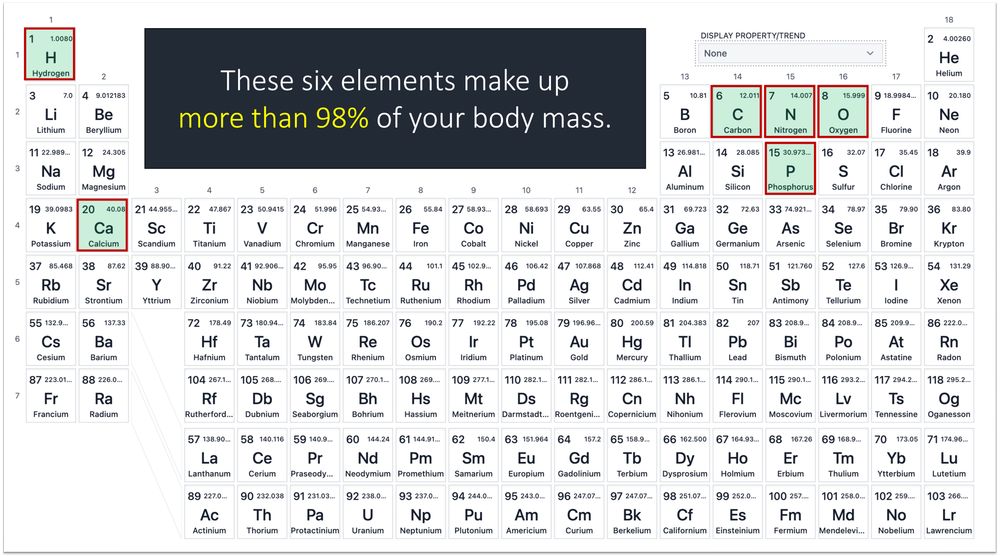
One thing you'll notice about these six elements is that they are relatively small (i.e., they have low atomic numbers, aka are low-Z elements).
In addition to being the most prevalent elements in the universe, their low atomic number allows them to more readily form stable chemical bonds.
To begin, it's essential to understand which elements make up the human body. Amazingly, just six compose >98% of your weight:
➤Oxygen: 61% (varies based on water composition)
➤Carbon: 23%
➤Hydrogen 10%
➤Nitrogen: 2.6%
➤Calcium: 1.0%
➤Phosphorus: 0.6%
https://buff.ly/3YU4dIY
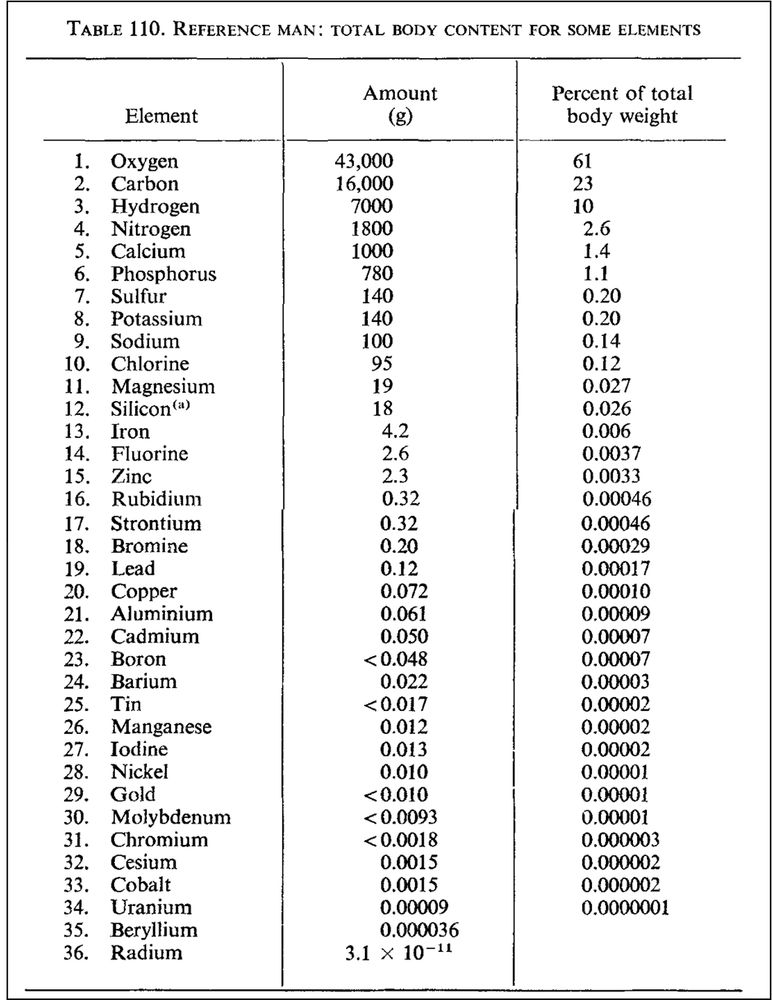
To begin, it's essential to understand which elements make up the human body. Amazingly, just six compose >98% of your weight:
➤Oxygen: 61% (varies based on water composition)
➤Carbon: 23%
➤Hydrogen 10%
➤Nitrogen: 2.6%
➤Calcium: 1.0%
➤Phosphorus: 0.6%
https://buff.ly/3YU4dIY
🤔 Why do we use iodine as an intravenous contrast agent?
The answer requires a review of the composition of the human body and a brief tour of one of my favorites, the Periodic Table of Elements.

🤔 Why do we use iodine as an intravenous contrast agent?
The answer requires a review of the composition of the human body and a brief tour of one of my favorites, the Periodic Table of Elements.
☞ Decreased mortality: OR 0.74, 95% CI 0.59-0.94
☞ RCTs alone: OR 0.95, 95% CI 0.72-1.26…


☞ Decreased mortality: OR 0.74, 95% CI 0.59-0.94
☞ RCTs alone: OR 0.95, 95% CI 0.72-1.26…
☞ Decreased mortality: OR 0.74, 95% CI 0.59-0.94
☞ RCTs alone: OR 0.95, 95% CI 0.72-1.26
https://buff.ly/40P2RBV


☞ Decreased mortality: OR 0.74, 95% CI 0.59-0.94
☞ RCTs alone: OR 0.95, 95% CI 0.72-1.26
https://buff.ly/40P2RBV

